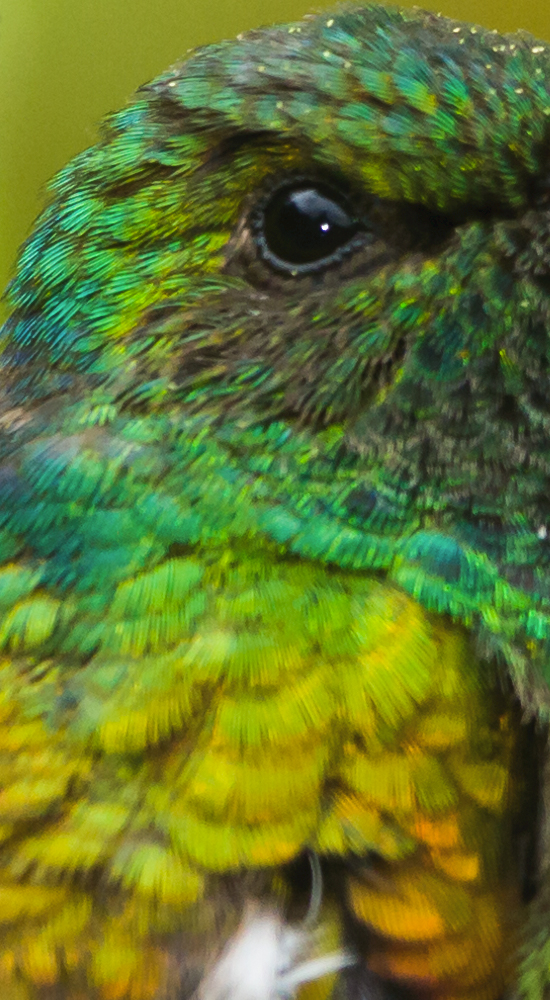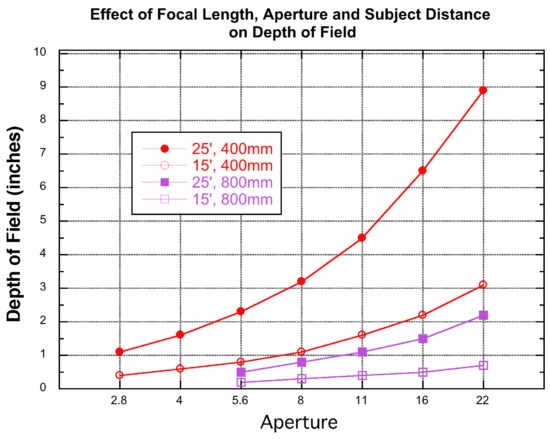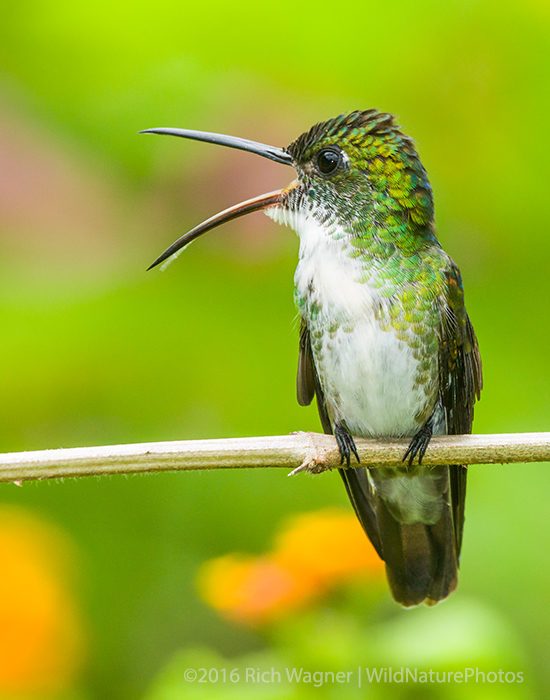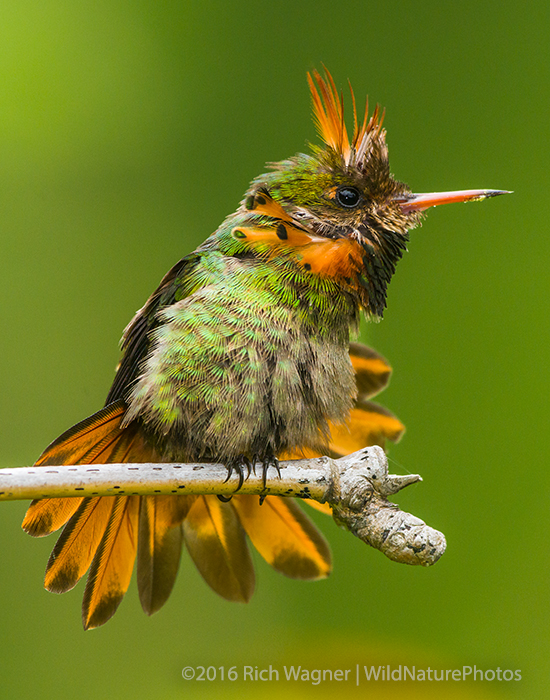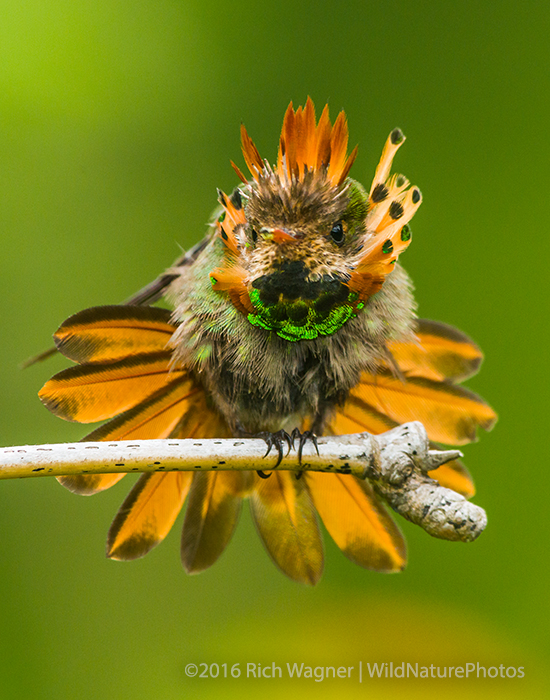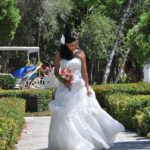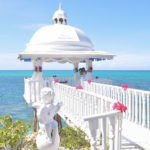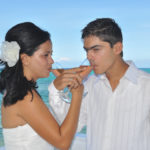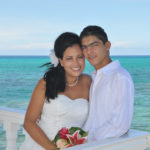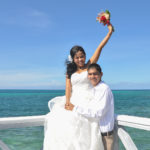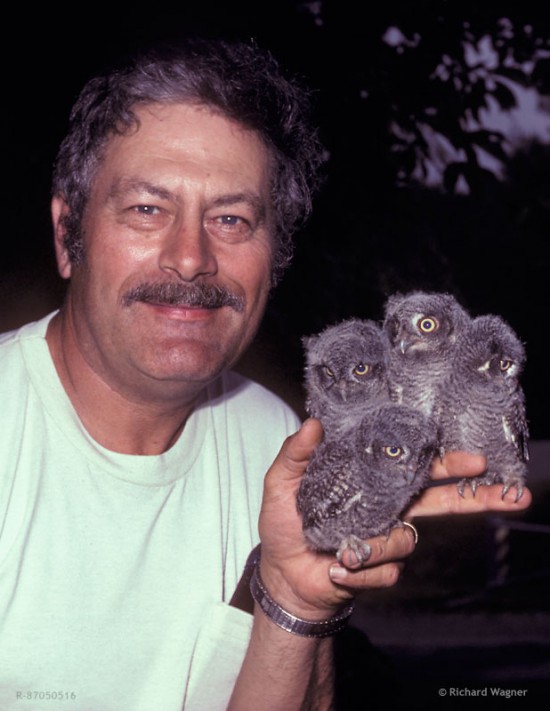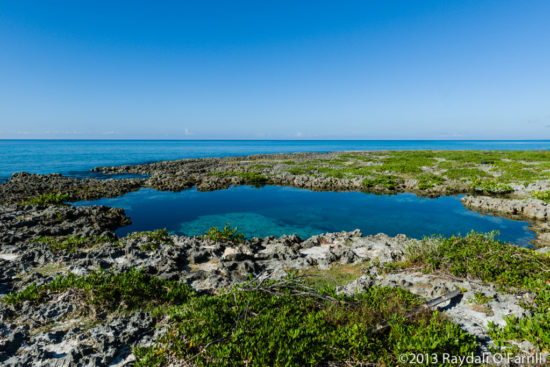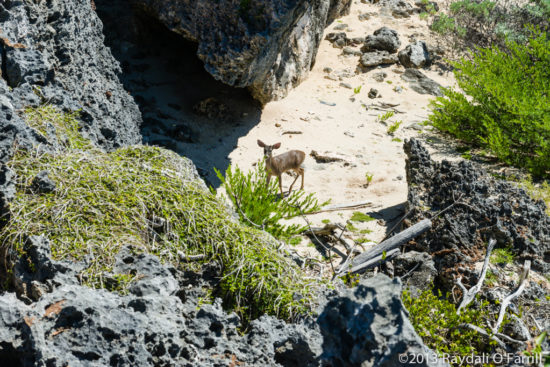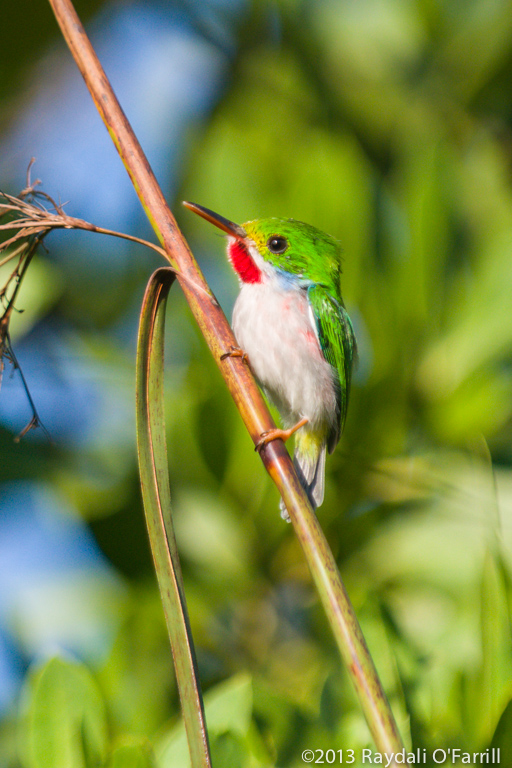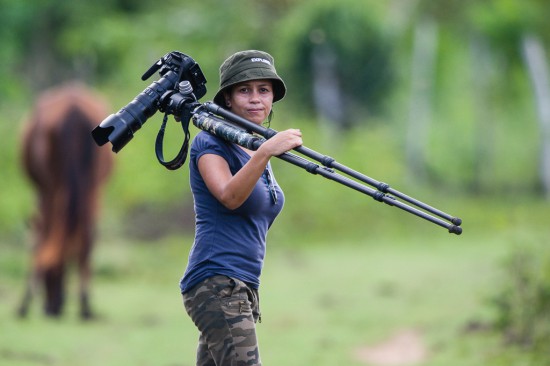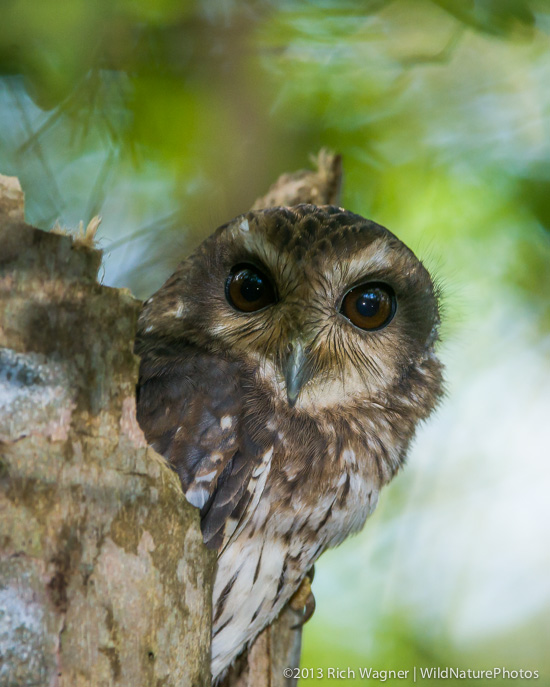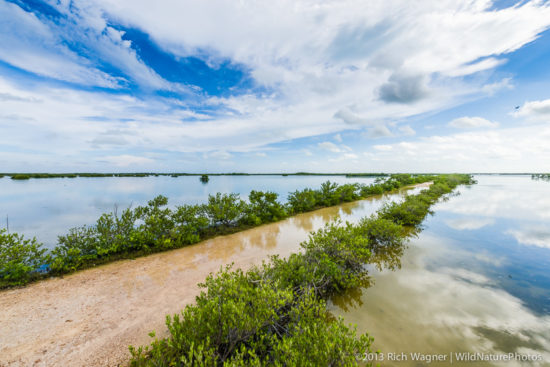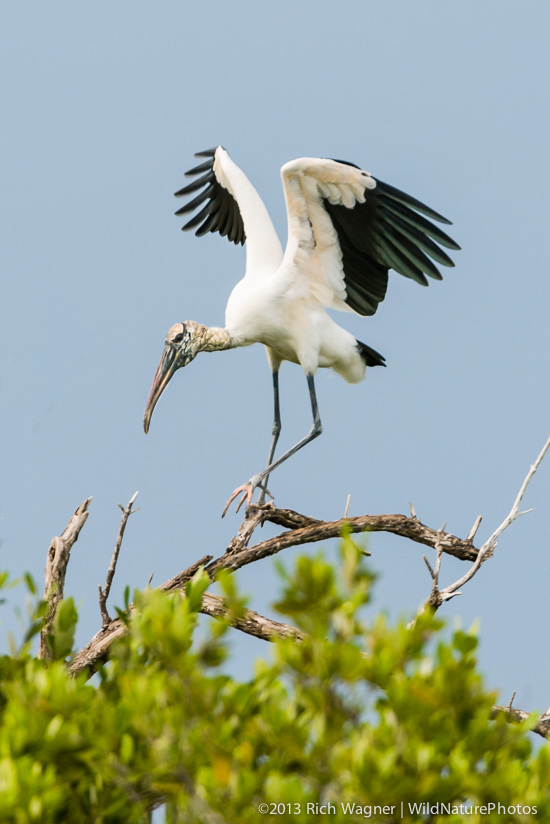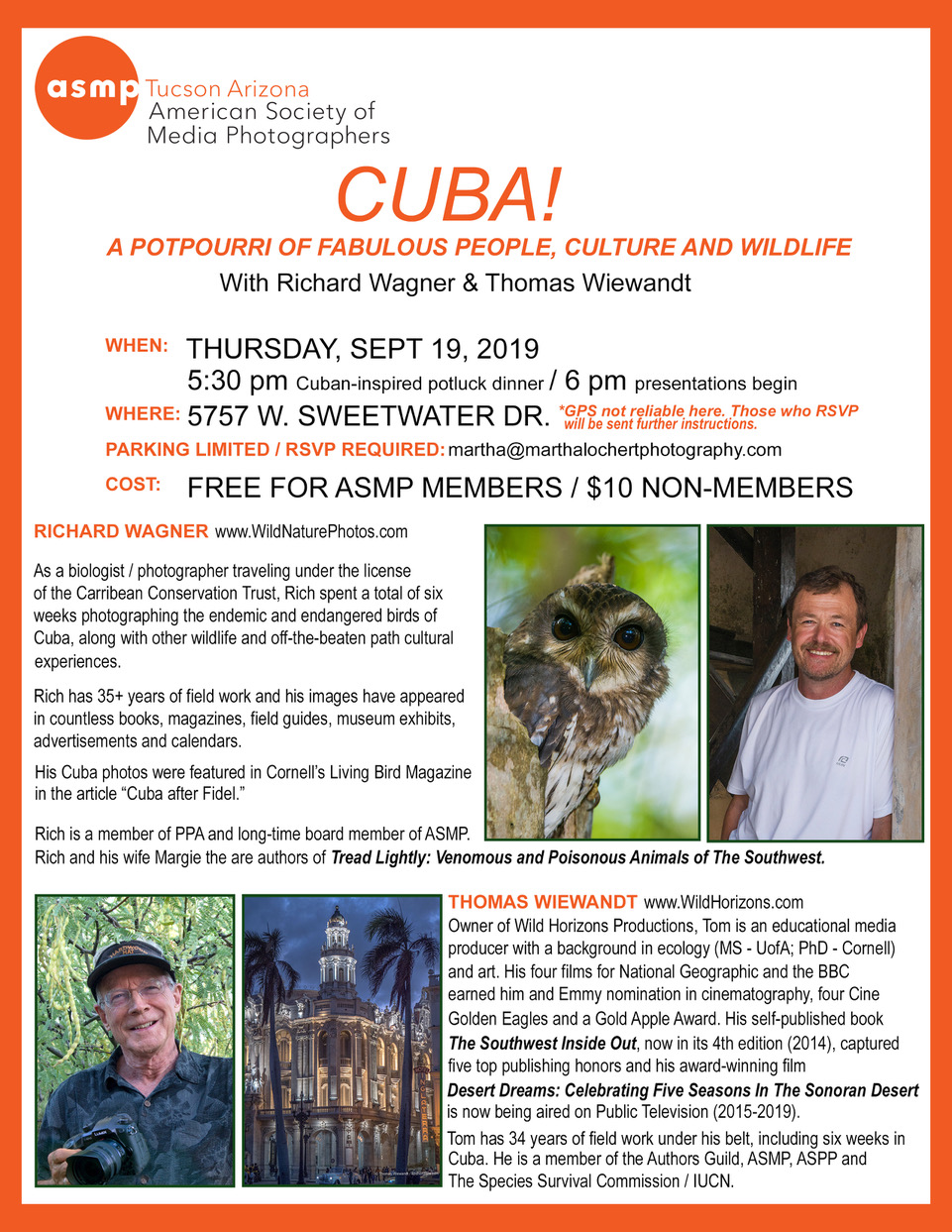
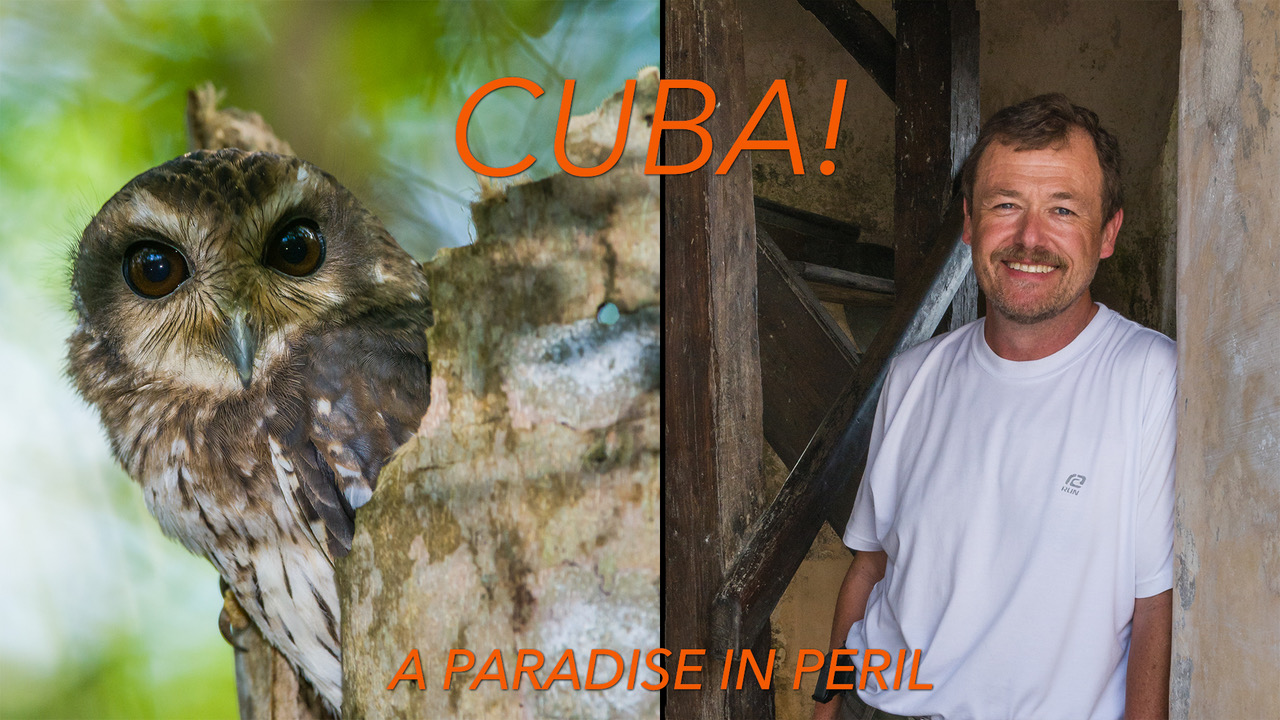
The island paradise of Cuba is in peril. Why? After attempts at economic strangulation by US sanctions, not surprisingly, the Cuban government turned to tourism as a source of hard currency. This is especially true on the North Coast. The North Coast islets (Cayo Coco, Cayo Guillermo, etc.) have undergone rapid development of massive “all-inclusive” resorts. There are currently 5,000 guest rooms, compared with a goal of 32,000 guest rooms. The construction of a 17 mile causeway between the mainland and the island of Cayo Coco caused an increased temperature and salinity of the water, resulting in a massive die-off of mangroves and fish, and a population decline of flamingos, iguanas and other wildlife. In an attempt to allow water circulation around the islets, gaps with bridges were retrofitted in the causeway, with dubious effectiveness. Unfortunately, the massive development effort continues! Where does the fresh water needed for the resorts come from? Where does the effluent go? What are the long-term consequences of this massive development? There are more questions than answers.
Tags: conservation, Cuba
The Challenge
Photographers often use telephoto lenses in the 400 – 800mm focal length range to photograph hummingbirds and other small wildlife. To help get good image size, close camera-to-subject distances of 15 – 25 feet are also often required. This presents some challenges that many photographers are not aware of. The exact point of focus on the subject is often critically important, focus itself must be critically accurate, the camera/lens must be rock steady, and regardless of aperture, the depth of field (DoF) will be surprisingly small. (Depth of field is the distance in front of and behind the point of focus in which the image appears sharp. If you want a basic introduction to depth of field and aperture, try this: A Beginner’s Guide to Aperture and Depth of Field.) I use specific strategies when shooting small subjects with long telephoto lenses to help bring home nice shots like this one of a Copper-rumped Hummingbird.
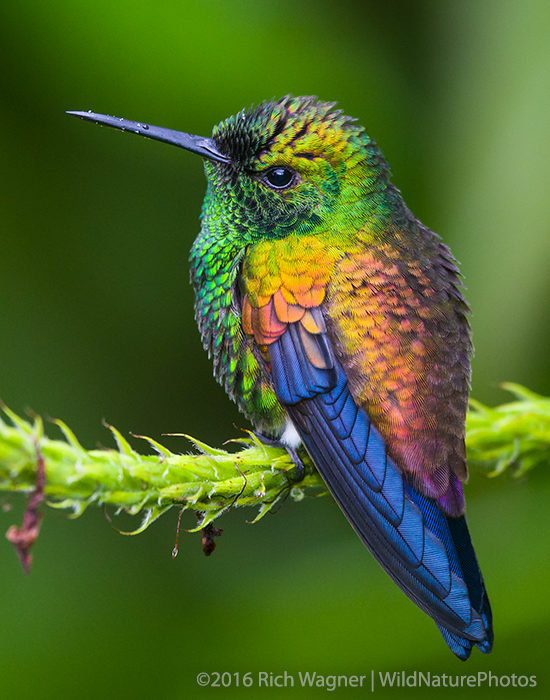
Copper-rumped Hummingbird (Trinidad)
This image is tightly cropped for the blog, to 7×9 inches at 300 ppi, to show detail. A close look at the pixels from a crop at 100% magnification from the original 36MP image shows excellent detail in all the feathers. (Right-click to download a larger image.) This photo was taken at 550mm (Nikon 400mm f2.8 + 1.4x Tele) at 1/100 sec, f5.6 at ISO 1000 with a Nikon D810 from about 25 feet, using balanced fill-flash on a vertical extender to help make the iridescent colors pop. The point of focus is just below the eye, and with this pose, the eye and almost all of the feathers of visual importance are in the same plane.
Even with a very slow shutter speed and nearly wide-open aperture, with minimal depth of field, the image appears sharp. This image could easily be used as a full-page or cover shot if not cropped so tightly.
The Problem
So what can go wrong? Here’s an example of the problem. I took the following image at the same 550mm focal length (400 f2.8 + 1.4x Teleconverter) at 1/200, f10, ISO 800 with a 36MP Nikon D810 from less than 15 feet on the same heavy Gitzo tripod, using fill-flash on a vertical extender. This is a JPG from a full-height vertical crop (3796 × 4912 pixels) from the 36MP image. (Right-click here to download a cropped 1:1 image)
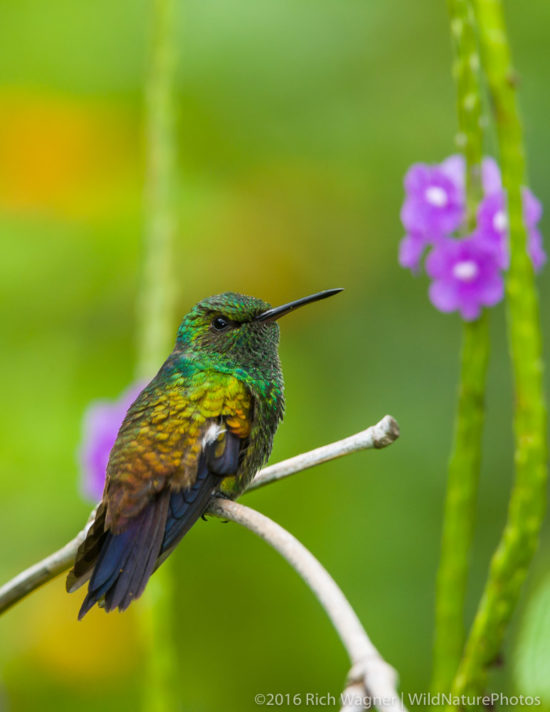
Copper-Rumped Hummingbird (Trinidad)
In this image, the eye and body feathers are not in the same plane. Here is a close-up screen shot at 1:1. Focus is slightly behind the eye. Note the feathers just to the left of the eye… then look down the body, as the feathers get closer to the lens. Even at f10, there is not much depth of field!
The lack of sharpness in this shot is dreadful. (Right-click the image for a larger 1:1 crop.) I could have improved this image by increasing the ISO to 1250 and stopping down another 2/3 stop, as well as focusing on the shoulder, instead of the eye, and splitting the DoF in front of and behind that focus point (with the risk that the eye is not sharp). The real problem is that the bird’s pose and the small depth of field at this focal length / distance makes it difficult to keep all the feathers sharp. This is especially true of those feathers closest to the camera, where the viewer’s eye normally looks. So just how small is the depth of field under these conditions? And how do focal length, camera-to-subject distance, and aperture affect the depth of field?
Calculating Depth of Field
There is an easy way to find out how focal length, camera-to-subject distance, and aperture affect the depth of field. The trick is to use a “Depth of Field Calculator” like this one, or my iPhone preference, TrueDoF-Pro.
I created the following chart using TrueDof-Pro and a standard “circle of confusion” of 0.03mm (30 microns) for the Nikon D800/D810, without the diffraction correction. The numbers represent the depth of field (area of acceptable sharpness) in front of / behind the point of focus, measured in inches! I have listed a single point in cases where the distance in front of / behind the focus point are the same. For any given focal length, you can read across the row for a given camera-to-subject distance and see how the depth of field increases with smaller apertures. Note that as the focal length increases, the overall depth of field decreases tremendously. With an 800mm focal length, wide open at f5.6, shooting a subject 20 feet away, the depth of field is only 0.3 inches in front of and behind the point of focus!
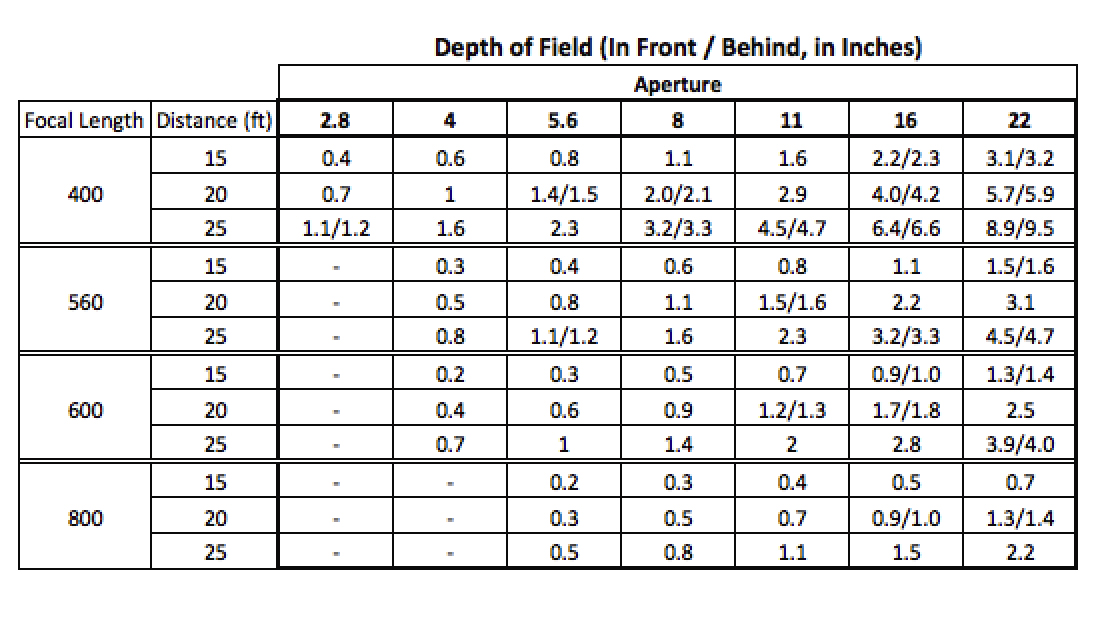
It is useful to look at a graph of the depth of field as a function of focal length, aperture, and camera-to-subject distance. I made the following comparison by graphing the above data. I chose two extremes of focal length (400mm and 800mm), along with the two extremes of distance (15 and 25 feet). It immediately becomes obvious that the benefit of increased depth of field obtained by stopping down diminishes tremendously with longer focal length, and even more so at short camera-to-subject distances. On the other hand, without stopping down at 800mm and with a short camera-subject distance, the depth of field is less than a quarter inch in front of/behind the focus point!
Diffraction and Sharpness
Some authors claim that the effects of diffraction will nullify any improvement beyond ~f8 achieved by stopping down. This is not my real-world experience. There is an excellent discussion of this topic, including an online diffraction limit calculator, available here. Note that diffraction limit is only a best-case scenario when using an otherwise perfect lens. Even when a camera system is near or just past its diffraction limit, other factors such as focus accuracy, motion blur and imperfect lenses are likely to be more significant.
Also, the depth of field equations generally in use are based on assumptions made for internally symmetric lenses, which super-telephoto lenses in the 400 – 800mm range are not. In particular, the so-called “pupil magnification” (P) becomes important with telephotos (and macros). Very generally, telephoto lenses have a P<1, asymmetric macros have a P>1, and symmetric designed lenses have a P=1. When P<1 it acts to increase depth of field. (If you’re shooting landscapes and want maximum sharpness and resolution from the D810 or comparable camera, I recommend this article. If you want the basic math, go here. For short discussions of pupil magnification, see 1, 2.)
Perhaps a better measure is to look actual measured sharpness, using data from DxOMark. DxOMark is the industry standard for camera, sensor and lens image quality measurements and ratings. Perceptual-Megapixel (P-Mpix) is a measure of sharpness. The number of P-Mpix of a camera/lens combination is equal to the pixel count of a sensor that would give the same sharpness if tested with a perfect theoretical optic as the camera/lens combination under test.
DxOMark has specifically tested the Nikon D810 with a Nikon 400mm f2.8 lens. This combination has a Lens Metric Score of 33 P-Mpix for sharpness. This score, compared with the maximum possible of 36.2, is excellent. The sharpness is comparable to a 33 MP camera with a perfect lens, and approximately 3.2 MP are “lost” due to less-than-perfect sharpness. That’s still far and away more that I usually need when photographing hummingbirds. The other measurements they provide are also supportive. Yes, some sharpness will be lost beyond f8 by stopping down, but the final test is the quality of the images that this setup produces. In print, they look great, even when used for two-page spreads.
Putting the Depth of Field Data to Use
So how is this information helpful when in the field shooting?
With relatively short telephoto focal lengths at short distances (~15 ft), stopping down is likely very helpful. With a 400mm lens at f2.8 vs f5.6, the depth of field increases from 0.4″ (in front/behind) to 0.8 inch. At medium distance (~25 ft), stopping down is not as important for depth of field, as f2.8 gives over an inch in front of the subject, which is likely adequate, especially if the subject can be framed in one plane. Even stopping down to f5.6 gives over 2.3 inches of DoF in front of the subject.
With long telephoto focal lengths, like 800mm, at short distance (~15 ft), shooting wide open at f5.6 gives a whopping +/- 0.2 inches of DoF! Tack-sharp focus and ~f16 will be needed to get even a half-inch of sharpness in front of and behind the focus point, which will increase the challenge of getting sharp-looking shots. At longer distances, the situation improves, but stopping down will still likely be helpful. Camera/lens movement at this focal length, especially with relatively slow shutter speeds, can also ruin an otherwise great shot.
Of course, the longer the focal length, the more defocussed and less distracting the background becomes, even with the lens stopped down. The closer the camera-to subject distance and the further away the background, the better, as far as blurring the background is concerned.
Getting It Right
Here are some real-wold examples:
I photographed this White-chested Emerald at 800mm, 1/250 at f16, ISO 1000, again with balanced fill-flash. The image links to a 1:1 Lightroom screenshot, and a high-res image can be downloaded here (6MB) to view sharpness at 1:1 magnification. With action, subject motion can blur the shot, resulting in the need to compromise between faster shutter speeds vs. increased depth of field. I opted for 1/250 second, hoping to freeze any motion. Note the sharp white breast feathers resting on the bird’s left shoulder. Diffraction clearly did not ruin this shot, nor did Nikon’s 2X teleconverter on the incredibly sharp 400mm f2.8 lens.
The Tufted Coquette is the second-smallest bird in the world – second only to the Bee Hummingbird that is endemic to Cuba. Males like this one weigh about 2.25 grams, less than the 2.5 gram weight of a penny! This male is about 2.75 inches from tip of bill to tip of tail. I took these shots with a focal length of 800mm, at /250 sec at f10, ISO 1000 from about 15 feet. My first challenge was to find a favored perch of this immature male, and then position myself where I had a decent background when he returned. Balanced fill-flash was essential to make his color pop from the background. The image again links to a Lightroom 1:1 screenshot.
Another shot, at 800mm, 1/250 sec, f11, ISO 1000. The image link to the 1:1 Lightroom screenshot of this male shows the new tuft feathers that are still in white sheathes. Females of this species have a buff-colored chest and no tuft feathers. Because the bird was leaning forward in this shot, the head became closer to the camera, and the tail further away. The focus distance on the face also changed, and became closer to the camera. Careful observation shows that the tail is (predictably) slightly more out of focus because of the shallow depth of field.
Strategies
- The longer the focal length that is being used (from the same distance), the greater the need to stop down to maintain adequate depth of field. Higher magnification goes hand-in-hand with smaller depth of field. That means slower shutter speeds and the need for rigid camera support. In low light, slow shutter speeds are obviously a problem, and supplemental light may be needed to obtain good results. Supplemental light also helps improve contrast.
- Camera-to-subject distance has a dramatic effect on depth of field when shooting with telephoto lenses. Be aware of this if shooting at the closet focus distance possible for the lens / focal length.
- Shooting “side-on” shots where most of the subject is in one plane will help create the appearance of sharpness and depth of field. “Over the shoulder, looking back” shots do the opposite. In the latter case, focus on the eye results in the part of the subject closest to the camera being unsharp. Thinking about the “plane of focus” instead of the “point of focus” will help you anticipate what will be soft or out of focus.
Tags: Copper-rumped Hummingbird, Depth of Field, Hummingbird Photography, Telephoto, Tufted Coquette, White-chested Emerald
If our Photoshelter login page has looked like it was on drugs recently, with completely screwed up formatting, there’s a good reason. In technical terms, it’s called a lack of CORS (cross-origin resource sharing, not Coors!). Like many other photographers, we use Photoshelter to provide the “back-end” image engine and e-commerce for our website. In general, it’s worked well for us since 2009. We used “Manual Customization” to integrate Photoshelter with our website, so that when a user logs in to make purchases, those purchases are actually made on Photoshelter’s secure servers over an encrypted “SSL” connection, commonly recognized by the “https://” prefix. It has been transparent to the end user, and it has worked well until recently.
So what’s the problem? As internet security has become an ever-increasing concern, browser developers as well as the internet community at large have recognized the ability of malicious hackers to spoof end users with fraudulent information in order to obtain credit card and other personal information. In response, browser manufacturers have tightened the restrictions on server-to-server communications to prevent “bad” code from getting injected into pages that a user views. Therefore, servers that make secure connections for e-commerce, like Photoshelter, now need to make special connections to other servers (like ours) via a CORS protocol. Unfortunately, Photoshelter’s Manual Customization interface was designed before the era of CORS and it has not been (and will not be) updated.
The result is that when a user goes to the photographer’s website login page, for example, Photoshelter appropriately makes a secure connection to a photo buyer’s computer, and then requests that additional information needed to maintain the “look and feel” of the website be downloaded from the photographer’s website to the login page. Because this request is not made with SSL (using the https:// protocol) and requests data from a different server, the browser sees it as potentially insecure and blocks the download of executable data, including Javascript and CSS needed to make the page render (display) correctly. Interestingly, browsers currently recognize “insecure” but non-executable data like jpg, png, and gif images when they are “mixed in” over a secure connection, but they allow those images to be rendered, even though they could provide misleading information to the end user like “Enter your bank routing number” in an otherwise nondescript text box. Regardless, the end result is that the login page and other secure pages being served by Photoshelter were a jumbled mess!
Photoshelter Support claimed to have no fix to this problem, and Photoshelter has decided not to update the “classic” user-customizable templates on which our site (and others) are built, even though the login and other secure pages were completely unusable. Their approach was to ignore the problem and hope users migrated to their new web design framework called Beam. But many photographers with custom websites, including us, don’t like the look or limitations of the Beam platform. One fix was proposed by David Brabyn (http://digitaltechparis.com/2014/12/fix-broken-photoshelter-login-page-problem-firefox-chrome/), but this only dealt with CSS problems and not Javascript problems. Photoshelter Support mentioned this in an email to me, and noted, “You are correct in that this issue will effect all members who are using manual customization (and on all major browsers), and [we have] not found a workaround. There have been members who have reached out to us regarding this same issue before, but I’m aware of only one who has opted to use David’s workaround with success.”
We have found a work-around that requires taking all of the javascript and CSS files that were linked to on our site by Photoshelter and compressing them using javascript and CSS compressors, then embedding that compressed data into the Public and Customer Page Master Templates that Photoshelter uses for manually customized web sites. By doing so, when Photoshelter is serving secure pages, there are no longer insecure (http://) calls from Photoshelter’s servers to our server for javascript or CSS files – the types of files that were blocked from being downloaded and that made page rendering fail. There is still a “mixed content warning” icon in the address bar for the .jpg, .png, .gif, etc files, but by default the images (and the entire page) are rendered correctly. The total character count for the compressed CSS/JS for our website is a handful of bytes over 30,000 characters, and the limit on the Photoshelter templates is around 60k. If the compressed data (and the rest of the HTML template) were larger than this, we would need to resort to pruning out what was not essential, perhaps as recommended by David Brabyn above for CSS.
The CSS compressor we use is CSSCompressor.com (at highest compression), and for javascript compression we use JSCompress.com. Not all compressors are equivalent, and files that are compressed and embedded should be verified individually.
We will migrate to a new website platform in the near future that does not require Photoshelter’s classic templates, and that will work equally well on mobile devices as well as desktops, but for the moment, we’re back in business, with a usable login to our website e-commerse page and light boxes. If you’ve had the same problem, or were confused by our jumbled login and other secure pages, I hope this helps.
Tags: Business, Photoshelter, Website
Raydali has been my Cuban guide for three two-week photography trips over the past couple of years, and she is simply awesome! Of course, trying to communicate with her in Cuba is difficult, but she was recently able to send me some photos of her recent wedding! She and Alejandro eloped to one of her favorite locations (only their parents and a few close friends knew, including yours truly), and they had a spectacular time. Complements to the outstanding photographer, Michel Castillo Velazquez, from Guardalavaca, Holguin. These images are from JPGs. Michel also shot (Nikon) NEFs and provided those to Raydali as well. Enjoy!!!

Raydali signs…
(Click on images to expand, then use the browser’s back arrow.)
- Bride arrives
- March together
- Say I do
- He signs
- She signs
- Wedding Rings
- Weddings Rings
- The Kiss
- Paradise!
- Toast Forever Together
- We drink
- We are happy
- Very Happy
- Ceremony over
- Newlyweds
- We made it!
Tags: Cuba
We seldom photograph in zoos or aquariums, except for pleasure, and our recent trip to Sea World, San Diego was a real pleasure! We were able to go “behind the scenes” to see Tobie, a Bottlenose Dolphin, two days before she delivered her fourth calf. On October 18, 2015, she delivered a beautiful, healthy 40-pound calf. It will take several weeks until the experts can determine whether this calf is male or female.
The moment Tobie saw us enter the “behind the scenes” area, she found her toy and flipped it up in the air, then grabbed it and raced toward us, reminiscent of the family dog wanting to play. She looked like she was doing very well, and this is fantastic news! Sea World does an awesome job with all of their animals, and you would be hard pressed to find others with such dedication.
Captive breeding is an important part of the conservation of species, including sea mammals, and Sea World should be given kudos for their many success stories. Those successes are not by accident, but rather, the result of years of very hard work by many dedicated people.
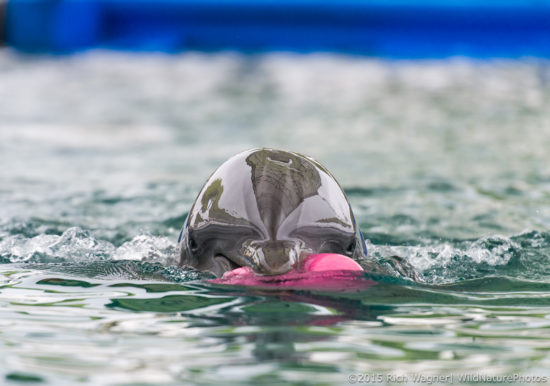
Tobie, a Bottlenose Dolphin at Sea World, San Diego, 2 days before she gave birth to her fourth calf.
Congrats to Tobie, Sea World, and the incredible vets and dolphin trainers (Susan M, thanks!!!) who put their hearts and souls into helping these wonderful animals. And yes, I got really nice photos of her.
Check out the video of Tobie and her baby on Facebook:
The world lost a great wildlife photographer yesterday…
and I lost a mentor and a good friend.
Internationally renowned wildlife photographer Ron Austing died peacefully yesterday at the age of 82, with his daughters, son and close friends at his bedside, after a hard-fought battle with lymphoma.
Ron Austing was born in Cincinnati, Ohio in 1931. His interest in wildlife began as a child, after his family moved to a suburb of Cincinnati called North College Hill. At the time, much of that small village was an undeveloped woodland, surrounded by small farms. This gave Ron the opportunity to observe nature relatively undisturbed. By the age of twelve he had become intimately associated with birds of prey: the hawks and owls, which initiated a lifelong passion with these birds. His other passion was baseball, and he spent several years working in the dugout of the Cincinnati Reds. He remained an avid Reds fan throughout his life.
Ron’s desire to remain close to nature led to his career as a Park Ranger with the Hamilton County Park District in Ohio; essentially, the parks in and surrounding Cincinnati. In his thirty years with the Park District he saw the parks grow from some three thousand acres in 1953 to over sixteen thousand when he retired as a Park Ranger in 1983. After twenty-four years as a Park Ranger, with the rank of Captain, he became disenchanted with law enforcement and resigned, but he was immediately appointed to be the Park District’s first Wildlife Manager, a post he retained until he ultimately retired. In 1982, Ron was awarded the Ohio Conservation Achievement Award by the State of Ohio and the Department of Natural Resources.
Beginning at a relatively young age, Ron combined his knowledge of wildlife with his skill as a photographer, and he became an internationally recognized wildlife photographer while in his teens. He published his first illustrated article while he was still in high school. Since then, his photos have appeared in literally thousands of publications, including National Geographic, Sports Illustrated, Audubon, National Wildlife, Ranger Rick, Birder’s World, Bird Watcher’s Digest, as well as countless other U.S and European publications.
In addition to the many articles, books and field guides featuring his photography of birds, Ron authored several books of his own. He wrote his first book, I WENT TO THE WOODS: the Autobiography of a Bird Photographer, while he was still in his twenties. He followed with THE WORLD OF THE RED-TAILED HAWK and THE WORLD OF THE GREAT HORNED OWL.
Birds were always Ron’s primary subject, especially birds of prey, Kirtland’s Warbler, neotropical migrants in general, as well as the nesting activities of a tremendous number of bird species. The more than fifty thousand transparencies, terabytes of digital files and hundreds of hours of video footage in his collection also include insects, mammals, reptiles, amphibians, trees, and flowers. The majority of subjects are representative of Eastern and Midwestern regions of the U.S., with some Western species and a limited number from the Canadian arctic, Ecuador and the Galapagos, Mexico, Africa and India. As the official photographer of the Cincinnati Zoo for many years, Ron’s photo collection includes controlled conditions or studio images of many internationally rare and endangered species.
I met Ron 31 years ago in the Education Department of the Cincinnati Zoo. We spent many wonderful years together working on wildlife photography projects in the U.S. and Canada. Ron was my Best Man at my wedding, and I was at his bedside when he died. A small sample of Ron’s work can be viewed on our website here and is available for licensing. I plan to provide a much larger selection of Ron’s work in the near future, and I will assist his family in keeping his photographic legacy alive. You can view more of Ron’s work on the website that he used for photographic print sales: www.RonAusting.com.
In lieu of flowers, donations may be sent to the following organizations that Ron supported:
Audubon Society of Ohio
3398 W. Galbraith Road
Cincinnati, OH 45239
Cincinnati Bird Club
2928 Saddleback Dr.
Cincinnati, OH 45244
Oxbow, Inc.
P.O. Box 4172
Lawrenceburg, IN 47025
RAPTOR, Inc.
961 Barg Salt Run Road
Milford, OH 45015
The Cornell Lab of Ornithology
159 Sapsucker Woods Rd
Ithaca, NY 14850
Update:
Memorial Service
An open gathering for family and friends will be held on Monday, June 30 from 5 pm until the time of the Memorial Service at 8 pm in the High Plains Shelter at the Miami-Whitewater Forest.
Tags: conservation, Hawks, Ron Austing
Cornell University Laboratory of Ornithology’s quarterly, award-winning Living Bird magazine has just published an article on Cuba in the current issue (Winter 2014) called “Cuba After Fidel Castro,” by George Oxford Miller and it features my photos on Birds of Cuba. The print version has been mailed to subscribers and it looks great! The layout is stellar, the images are generally very big, and the article itself is very informative. I have a few minor nit-picks with the article – there are now 26 endemic bird species in Cuba, not 21 – but the gist of the article is that the future of Cuba’s wildlife is up in the air – a point that is certainly not in dispute. The online version of the magazine is always one issue behind the print version, so you can look for it online in about three months, or better yet, check out the magazine and subscribe now!
http://www.allaboutbirds.org/page.aspx?pid=1085.
If you are wondering which seven images were selected by Living Bird, they are included within this big gallery here. 😉 (i.e., I’m not telling!)
Tags: Bee Hummingbird, Birding, conservation, Cuba, Endangered Species, endemic
I’ve made a ‘top ten list’ of endemic birds that I have photographed in Cuba while surveying birds for the Caribbean Conservation Trust – well, make it the top 12! Several are highly endangered, others just look great. Here they are, in no particular order:
This female Fernandina's Flicker (Colaptes fernandinae) is one of the most rare woodpeckers in the world, second only to the Ivory-billed Woodpecker. Near Bermejas, Zapata Peninsula, Cuba. (Richard Wagner/©2013 Rich Wagner | WildNaturePhotos)
Zapata Sparrow (Torreornis inexpectata inexpectata), Cuba (© 2012 Rich Wagner | WildNaturePhotos)
A rare, endemic, and highly endangered Zapata Sparrow (Torreornis inexpectata inexpectata). La Turba, Cuba (WildNaturePhotos/© 2012 Rich Wagner | WildNaturePhotos)
A Cuban Screech Owl (Margarobyas lawrencii) looks out from a roost tree, near Bermejas, Zapata Peninsula, Cuba. (Richard Wagner/©2013 Rich Wagner | WildNaturePhotos)
A Cuban Screech Owl (Margarobyas lawrencii) looks out from a roost tree, near Bermejas, Zapata Peninsula, Cuba. (Richard Wagner/©2013 Rich Wagner | WildNaturePhotos)
An endemic Cuban Green Woodpecker (TXiphidiopicus percussus) on a palm tree trunk in Hacienda Cortina, Pinar del Rio Province, Cuba (Richard Wagner/©2013 Rich Wagner | WildNaturePhotos)
The endemic Cuban Trogon (Priotelus temnurus) is the national bird of Cuba. La Guira National Park, Cuba. (WildNaturePhotos/© 2012 Rich Wagner | WildNaturePhotos)
A highly endangered, endemic Zapata Wren (Ferminia cerverai) singing, in the heart of the Zapata Swamp, near Santo Tomás. Cuba. (Richard Wagner/©2013 Rich Wagner | WildNaturePhotos)
Bee Hummingbird (Mellisuga helenae), male in non-breeding plumage, perched. Cuba (© 2012 Rich Wagner | WildNaturePhotos)
Bee Hummingbird (Mellisuga helenae), male in non-breeding plumage, in flight near the red flowers of Firebush (Hamelia patens). Cuba (WildNaturePhotos/© 2012 Rich Wagner | WildNaturePhotos)
A Cuban Tody (Todus multicolor) in the heart of the Zapata Swamp, near Santo Tomás. Cuba. (Richard Wagner/©2013 Rich Wagner | WildNaturePhotos)
The endemic, highly endangered Blue-headed Quail-Dove (Starnoenas cyanocephala) can frequently be seen near Bermejas very early in the morning. Zapata Peninsula, Cuba. (Richard Wagner/©2013 Rich Wagner | WildNaturePhotos)
The Cuban Solitaire (Myadestes elisabeth), often called the Cuban Nightingale, has a flute-like voice and is considered the best singer of the birds of Cuba (endemic of Cuba). (WildNaturePhotos/© 2012 Rich Wagner | WildNaturePhotos)
Cuban Parrots (Amazona leucocephala leucocephala) feeding in the early morning. Playa Larga, Cuba. (WildNaturePhotos/© 2012 Rich Wagner | WildNaturePhotos)
An endemic Cuban Pigmy Owl (Glaucidium siju) perched in a tree. Bermejas, Zapata Peninsula, Cuba. (Richard Wagner/©2013 Rich Wagner | WildNaturePhotos)
Looking for more? You can see a portfolio of large images of Cuban birds here. This link also works well for iPads, as iOS doesn’t support the Flash-based links used above, and the portfolio is color managed (even on wide-gamut displays!). You can also check out my other posts on endangered / endemic birds in Cuba.
Tags: Cuba, Endangered Species, endemic
I just returned from my second two-week trip to Cuba with the Caribbean Conservation Trust to survey and photograph the avian fauna of Cuba. Once again, my guide Raydali O’Farrill was fantastic, as were my local guides Osmany in Guanacahabibes, Caesar in San Diego, and Angel and Orlando in Zapata.
This trip was taken prior to the usual tourist season, and it was still the rainy season in Cuba. The first few days in Guanacahabibes were pretty wet, as a storm passed through, and it was decidedly un-birdy, with the exception of a lot of female and immature Bee Hummingbirds. The consensus among all of the Cuban guides I spoke with on this trip is that the male Bee Hummingbirds molt and lose their gorget color after the breeding season, which is very interesting. I’m not familiar with any other hummers that do this. The males of the Vervain Hummingbird in Hispaniola (almost as small) have no throat color at all. I’m curious what’s different in Hispaniola and Cuba that results in these differences from other hummingbirds. According to the local guides, the best time to see/photograph male Bee Hummers in breeding plumage is in March-June, when the gorget is in full color.
We did not find any migrants at Cabo San Antonio, but it was nice to go to the western-most tip of Cuba. In fact, on this trip in general we found very few migrants: predominantly a few Broad-winged Hawks and a handful of warblers. That will change decidedly in November! With thanks to Osmany, we took many excellent landscape shots of this most unusual habitat, and I also got my best Cuban Tody shot to date.
I turned Raydali into a photographer on the trip with my backup camera and some brief instruction – she did incredibly well! She is a quick study and she has a good eye. She used my backup Nikon D800E and we frequently swapped lenses – it was easier for me than carrying everything. Ray spotted and photographed the only deer that Osmany has ever seen or heard of in Guanacahabibes – very cool! She also got excellent shots of Cuban Tody and others. She’s a natural.
In San Diego, I got excellent photos of Cuban Green Woodpecker and a few other endemics, but we struck out on Cuban Grassquit, even after two attempts. Raydali saw the Grassquits once and got a nice “record shot.” Caesar tells me that March-April are fantastic for this species (and many others). He was also frustrated at not locating many Cuban Grassquits, but we made good efforts – the birds were just not there in significant numbers. The resident Kestrel was once again present across the road from El Mirador Hotel, giving Raydali lots of opportunity to practice taking photos. In fact, we saw more than a dozen Kestrels on roadside power lines in the area. A bonus in this area was a male Olive-Capped Warbler.
Zapata was a gold mine, as expected. Angel in particular knew the light I was looking for, the direction I needed to shoot from, etc. He and Orlando did a great job locating Cuban Pigmy Owl, Cuban Screech Owl, Fernandina’s Flicker, Blue-headed Quail-Dove, Grey-headed Quail Dove, Bee Hummingbird, and others. We had more difficulty with Zapata Wren, until we took a boat through the Zapata Swamp at Santo Thomas. The wren insisted on maintaining a position where it was primarily back-lit, but I was still able to obtain a few excellent shots. The swamp itself is absolutely magnificent!
Perhaps most incredible was a trip to La Salina. It was decidely different from last November, when the water level was low and Flamingos were seen by the thousands. This time, the road was nearly always covered with water and wading birds! The van was like being in a boat going down a channel. The birds were primarily located on the water-covered road or in the vegetation on the edges of the road. Notable were many species of egrets, Cuban Black Hawk, a Roseate Spoonbill, and several Wood Stork.
I now have a lot of editing / keywording to do to prepare images from this trip, but I’m anxiously looking forward to a return trip next year.
Cuba is home to at least 26 endemic bird species — birds found no where else in the world — including the Bee Hummingbird (the smallest bird on our planet), the Cuban Screech Owl and Cuban Tody. The Zapata Sparrow is the only sparrow endemic to the West Indies. Nine of the endemic species of Cuba are endangered or vulnerable, and a dozen or so endemic subspecies have the potential for full species status. This high level of endemism alone signifies Cuba as a globally important place for birds. Cuba is also one of the most important wintering and stopover sites for North American migrant birds, and over 100 North American nesting species winter in or pass through Cuba on migration. If you are interested in traveling to Cuba and participating in an ongoing scientific survey of the birds of Cuba, including both endemic and migratory species, I highly recommend that you contact Gary Markowski of the Caribbean Conservation Trust.
A quick update on November 19 – I have now uploaded about 170 images of endemic / endangered birds from Cuba and surrounding habitat shots that can be viewed as a portfolio from this link (with big images) or you can browse the images in a gallery here:
Tags: conservation, Cuba, Endangered Species, endemic

